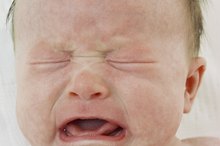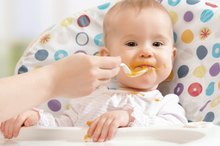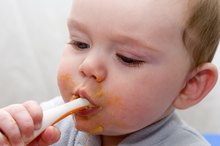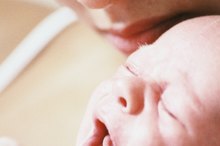What Could Cause a Recurring Rash on the Face of a Breastfed Baby>
Like spit-up and dirty diapers, a recurrent rash on the face of a breastfed baby is often a natural part of babyhood that infants grow out of. But the red irritation could also mean that your baby’s body is reacting to a food or chemical. Learn the facts about ongoing facial rashes in babies so you can determine whether that rash will pass on its own -- or if it calls for a visit to the pediatrician.
Allergic Causes
A rash that appears repeatedly on a breastfed baby’s face may indicate an allergic reaction 1. This type of topical inflammation could develop from something that you ate or from a substance that your baby’s face comes in contact with when nursing. The most common dietary causes of facial rashes in babies are cow’s milk dairy products that the mother consumed. Environmental allergens that could contribute to pediatric facial irritation include soaps, detergents, lotions and moisturizers.
- A rash that appears repeatedly on a breastfed baby’s face may indicate an allergic reaction 1.
- This type of topical inflammation could develop from something that you ate or from a substance that your baby’s face comes in contact with when nursing.
Baby Acne
Scented Lotion While Breastfeeding
Learn More
Babies between the ages of 3 weeks and 6 months often experience an ongoing, harmless facial rash called baby acne, which shows up in the form of small red bumps sprinkled across the cheeks, forehead or chin. Called seborrheic dermatitis in medical circles, this form of rash develops as a natural consequence of the maternal hormones present in the baby’s body from before birth. The rash often appears to worsen when a child gets upset or cries, because this increases blood flow to the blood vessels under the facial skin.
Symptoms
A facial rash may appear as small pimple-like bumps, large spots or irregular, spread-out splotches. Although it often appears in isolation, be prepared to look for other symptoms, especially if you suspect an allergic sensitivity may be causing the rash. Symptoms of a food-linked allergic sensitivity may include irritability, stomach pain and gas after nursing, as well as vomiting, diarrhea or excessive spit-up. Topical skin irritation caused by environmental allergens may be accompanied by skin dryness and itchiness.
- A facial rash may appear as small pimple-like bumps, large spots or irregular, spread-out splotches.
- Symptoms of a food-linked allergic sensitivity may include irritability, stomach pain and gas after nursing, as well as vomiting, diarrhea or excessive spit-up.
Treatment
Red Bumps on Babies' Skin
Learn More
Baby acne typically clears up by itself, often within a few weeks of its initial appearance, but allergy-linked facial rashes usually need a helping hand. Clean your baby’s face with plain water or mild baby soap, and stop using lotions and irritating soaps on any skin that comes in contact with your baby’s face. Switch to a gentler laundry detergent, and consider running each wash through a double rinse to help ensure that the detergent debris rinses cleanly from your clothes. Contact your baby’s pediatrician if the rash worsens or if other symptoms appear 2. Depending on the symptoms and physical examination, he may prescribe a topical anti-inflammatory medication or ask you to eliminate certain foods from your diet for a period to see whether the rash improves.
- Baby acne typically clears up by itself, often within a few weeks of its initial appearance, but allergy-linked facial rashes usually need a helping hand.
- Switch to a gentler laundry detergent, and consider running each wash through a double rinse to help ensure that the detergent debris rinses cleanly from your clothes.
Related Articles
References
- “Pediatric Allergy, Asthma and Immunology”; Dr. Arnaldo Cantani; 2008
- “Pediatric Telephone Advice”; Dr. Barton Schmitt; 2004
- “Counseling the Nursing Mother”; Judith Lauwers, et al.; 2010
- Martin PE, Eckert JK, Koplin JJ, et al. Which infants with eczema are at risk of food allergy? Results from a population-based cohort. Clin Exp Allergy. 2015;45(1):255-64. doi:10.1111/cea.12406
- Waserman S. Doctor, can we prevent food allergy and eczema in our baby?. Curr Opin Allergy Clin Immunol. 2016;16(3):265-71. doi:10.1097/ACI.0000000000000267
- Wopereis H, Sim K, Shaw A, Warner JO, Knol J, Kroll JS. Intestinal microbiota in infants at high risk for allergy: Effects of prebiotics and role in eczema development. J Allergy Clin Immunol. 2018;141(4):1334-1342.e5. doi:10.1016/j.jaci.2017.05.054
Writer Bio
Regan Hennessy has been writing professionally for 11 years. A copywriter and certified teacher, Hennessy specializes in the areas of parenting, health, education, agriculture and personal finance. She has produced content for various websites and graduated from Lycoming College with a Bachelor of Arts in English.









